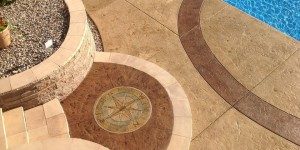 Stamped concrete is the result of adding color and texture to concrete that is in a fresh state, in order to resemble the appearance of materials such as: stones, slabs, terracotta, bricks, pavers, etc.
Stamped concrete is the result of adding color and texture to concrete that is in a fresh state, in order to resemble the appearance of materials such as: stones, slabs, terracotta, bricks, pavers, etc.
The use of stamped concrete is growing due to its versatility and eye-catching; it also has two important advantages over other materials: durability and cost. Stone and brick slabs are options that, despite their good visual impression, have two major drawbacks: a long construction time and the price of materials and the specialized labor they require, they deserve a very high budget. , as regards the surface finish for floors. They also have mortar joints where water can enter, resulting in the consequences known to all.
Stamped concrete, on the other hand, has the appearance of individual pieces of flagstone, but in reality it is a single piece of inexpensive, durable and visually pleasing concrete, which will also be ready to be used two or three days after having been emptied.
Now think of all the time and money this can save you!
Decorated concrete offers less cost, more durability, and inherent strength. It is ideal for pedestrian flats, gardens, shopping centers, roads, parking lots, parks, garages, walkways and many other places.
This process is so simple that it only consists of four stages:
- Addition of hardening color to fresh concrete.
- Addition of release color to fresh concrete to prevent the molds from sticking to the concrete and to give it enhancement and realism, as if it were a natural stone.
- Stamping of fresh concrete with high quality polyurethane molds and realistic design.
- Finally, the application of the sealer on the dry concrete to give it more enhancement and protect the color from dust, sun, water, and other factors.
